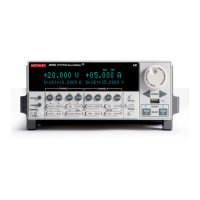Section 6: Instrument programming Model 2657A High Power System SourceMeter® Instrument Reference Manual
6-54 2657A-901-01 Rev. B/December 2012
Using the reset() command
Most TSP-Link
®
system operations target a single node in the system, but the reset() command
affects the system as a whole by resetting all nodes to their default settings:
-- Reset all nodes in a TSP-Link system to their default state.
reset()
Using the reset() command in a TSP-Link network differs from using the tsplink.reset()
command. The tsplink.reset() command reinitializes the TSP-Link network, but does not
change the state of the individual nodes in the system.
Use node[N].reset() or localnode.reset() to reset only one of the nodes. The other nodes
are not affected. The following programming example illustrates this type of reset operation with code
that is run on node 1.
-- Reset node 1 only.
node[1].reset()
-- Reset node 1 only.
localnode.reset()
-- Reset node 4 only.
node[4].reset()
Using the abort command
An abort command terminates an executing script and returns all nodes to local operation (REM
indicators turn off). This dissolves the master/subordinate relationships between nodes. To invoke an
abort operation, either send an abort command to a specific node or press the EXIT (LOCAL) key
on any node in the system.
You can also perform an abort operation by pressing the OUTPUT ON/OFF control on any node. The
results are the same as above, with the addition that all source-measure unit (SMU) outputs in the
system are turned off.
Triggering with TSP-Link
The TSP-Link
®
expansion interface has three synchronization lines that function similarly to the digital
I/O synchronization lines. See Digital I/O
(on page 3-80) and Triggering (on page 3-31) for more
information.
TSP advanced features
Use the Test Script Processor (TSP
®
) scripting engine's advanced features to:
• Run test scripts simultaneously
• Manage resources allocated to test scripts that are running simultaneously
• Use the data queue to facilitate real-time communication between nodes on the TSP-Link
®
network
When test scripts are run simultaneously, it improves functional testing, provides higher throughput,
and expands system flexibility.
NOTE
